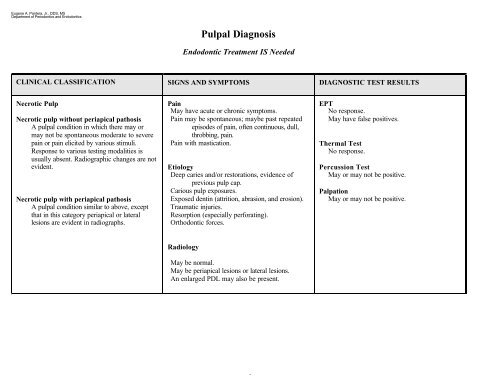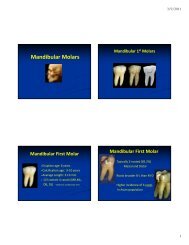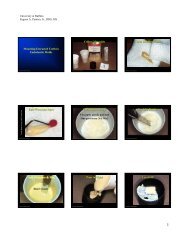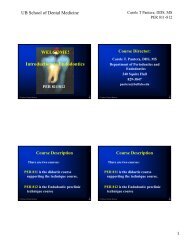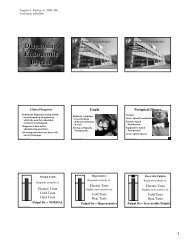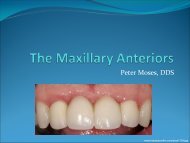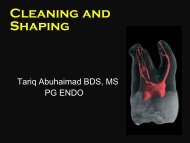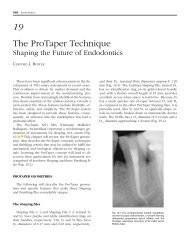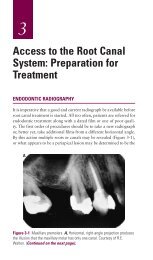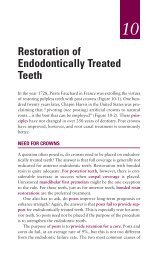Pulpal Diagnosis - University at Buffalo
Pulpal Diagnosis - University at Buffalo
Pulpal Diagnosis - University at Buffalo
You also want an ePaper? Increase the reach of your titles
YUMPU automatically turns print PDFs into web optimized ePapers that Google loves.
Eugene A. Pantera, Jr., DDS, MS<br />
Department of Periodontics and Endodontics<br />
<strong>Pulpal</strong> <strong>Diagnosis</strong><br />
Endodontic Tre<strong>at</strong>ment IS Needed<br />
CLINICAL CLASSIFICATION SIGNS AND SYMPTOMS DIAGNOSTIC TEST RESULTS<br />
Necrotic Pulp<br />
Necrotic pulp without periapical p<strong>at</strong>hosis<br />
A pulpal condition in which there may or<br />
may not be spontaneous moder<strong>at</strong>e to severe<br />
pain or pain elicited by various stimuli.<br />
Response to various testing modalities is<br />
usually absent. Radiographic changes are not<br />
evident.<br />
Necrotic pulp with periapical p<strong>at</strong>hosis<br />
A pulpal condition similar to above, except<br />
th<strong>at</strong> in this c<strong>at</strong>egory periapical or l<strong>at</strong>eral<br />
lesions are evident in radiographs.<br />
Pain<br />
May have acute or chronic symptoms.<br />
Pain may be spontaneous; maybe past repe<strong>at</strong>ed<br />
episodes of pain, often continuous, dull,<br />
throbbing, pain.<br />
Pain with mastic<strong>at</strong>ion.<br />
Etiology<br />
Deep caries and/or restor<strong>at</strong>ions, evidence of<br />
previous pulp cap.<br />
Carious pulp exposures.<br />
Exposed dentin (<strong>at</strong>trition, abrasion, and erosion).<br />
Traum<strong>at</strong>ic injuries.<br />
Resorption (especially perfor<strong>at</strong>ing).<br />
Orthodontic forces.<br />
EPT<br />
No response.<br />
May have false positives.<br />
Thermal Test<br />
No response.<br />
Percussion Test<br />
May or may not be positive.<br />
Palp<strong>at</strong>ion<br />
May or may not be positive.<br />
Radiology<br />
May be normal.<br />
May be periapical lesions or l<strong>at</strong>eral lesions.<br />
An enlarged PDL may also be present.<br />
3


